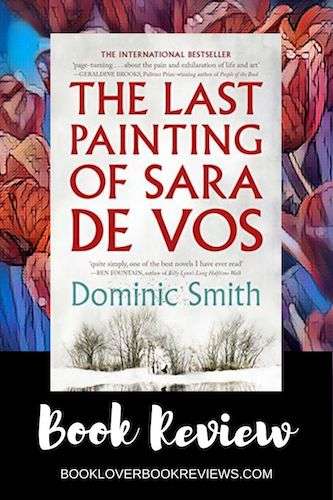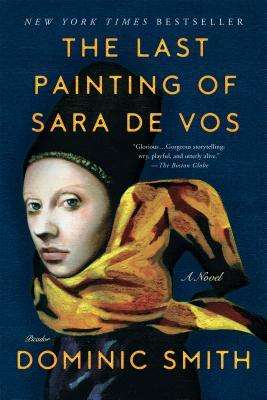The Last Painting of Sara de Vos by Dominic Smith, Review
The Last Painting of Sara de Vos, Dominic Smith’s fourth novel is a captivating multi-timeline literary mystery exploring the art of life. Read my full review.
The Last Painting of Sara de Vos Synopsis

A dazzling and mesmerising story that charts the collision course between a rare landscape by a female Dutch painter of the golden age, an inheritor of the work in 1950s Manhattan, and a celebrated art historian who painted a forgery of it in her youth. A literary novel of breathtaking scope, ambition and achievement.
This is what we long for: the profound pleasure of being swept into vivid new worlds, worlds peopled by characters so intriguing and real that we can’t shake them, even long after the reading’s done. In this extraordinary novel, The Last Painting of Sara de Vos, Australian writer Dominic Smith brilliantly bridges the historical and the contemporary, tracking a collision course between a rare landscape by a female Dutch painter of the Golden Age, an inheritor of the work in 1950s Manhattan, and a celebrated Australian art historian who painted a forgery of it in her youth.
In 1631, Sara de Vos is admitted to the Guild of St. Luke in Holland as a master painter, the first woman to be so honoured. Three hundred years later, only one work attributed to de Vos is known to remain – a haunting winter scene, At the Edge of a Wood, which hangs over the Manhattan bed of a wealthy descendant of the original owner. An Australian grad student, Ellie Shipley, struggling to stay afloat in New York, agrees to paint a forgery of the landscape, a decision that will haunt her. Because now, half a century later, she’s curating an exhibition of female Dutch painters, and both versions threaten to arrive.
As the three threads intersect with increasing and exquisite suspense, The Last Painting of Sara de Vos mesmerises while it grapples with the demands of the artistic life, showing how the deceits of the past can forge the present.
(Allen and Unwin, 2016)
Genre: Literature, Historical, Drama, Mystery
Disclosure: If you click a link in this post we may earn a small commission to help offset our running costs.
Sign up to our Booklover Book Reviews emails and receive our gift for new subscribers. LEARN MORE >>
Book Review
I am sure I am not the only book lover drawn to novels about art, those who create it and those who appreciate it. The thematic ties are clear – I consider quality writing an art form and every artwork tells its own story. But on another level, I actually think it is also their meta qualities that I find particularly engaging. Then, if you add in multiple narrative timelines and viewpoints, well the author really ‘has me at hello’. This was the case with Dominic Smith’s The Last Painting of Sara de Vos.
Impeccably detailed research into the Dutch Golden Age painting process shines through Smith’s rich prose. His knack of harnessing prosaic details for symbolic effect and thematic echoing across the timelines is so subtly done but the effect is captivating. For example, the artist’s painstaking process of layering oils on canvas to achieve particular visual effects and the techniques used by art restorers, paralleled to the experiences over a lifetime that shape us all, at first building up our outward personas, encapsulating joy, grief and regret and then the inevitable aging process.
The past is more alive to her than the present, she realizes, and the thought is suffocating.
Related Reads: The Art Forger by B A Shapiro and The Painting by Alison Booth
Descriptive prose
In The Last Painting of Sara de Vos, Dominic Smith reveals his characters’ complex inner lives through wonderfully descriptive prose. The moods he skilfully evokes range from witty and darkly cutting
Her dissertation on Dutch women painters of the Golden Age sits unfinished in her apartment, a half-typed sheet of paper mildewing in the mouth of a Remington. It’s been months since she worked on it and she sometimes finds herself staring at the machine’s bullnose profile or the chrome-plated carriage return, thinking: Remington also makes rifles.
to artistic and wistful,
The lights have been dimmed and the window is awash in the blackness and he can see a hairline fracture of dawn against the horizon.
through to the haunting
The sonic world of the foyer and vestibule comes at him distorted and from a distance, as if someone’s moving furniture underwater.
and ethereal.
There are pockets of time, she thinks, where every sense rings like a bell, where the world brims with fleeting grace.
Compelling mystery
But as much as I savour prose artistry, it is the interwoven mystery elements that propel this largely reflective story along. The tension and suspense cultivated by Smith’s judicious revelation of the alternating timelines and character viewpoints make this a literary page-turner.
Audiobook or written form
Edoardo Ballerini ranks among my favourite audiobook narrators – to this day I have vivid memories of his masterful performance of Jess Walter’s Beautiful Ruins. So when I realised he had also narrated The Last Painting by Sara de Vos I borrowed that format from my library and quickly found myself swept away. Or at least I was until the narrative shifted to contemporary Australia and his performance of the accent of my homeland broke the spell for me. So instead of letting that detract from Smith’s otherwise luminous prose, I switched to this novel’s written format and quickly regained my immersive state.
Dominic Smith’s The Last Painting of Sara de Vos is literary historical fiction to be savoured and the questions on life and art that it poses are deserving of quiet reflection. I recommend it be reserved for an opportunity that will afford readers the time to do so.
BOOK RATING: The Story 4.5 / 5 ; The Writing 5 / 5 ; Overall 4.75
Get your copy of The Last Painting from Sara de Vos
Compare retailers >>.
More highly recommended historical novels:
More The Last Painting of Sara de Vos reviews
‘Highly evocative of time and place, this stunning novel explores a triumvirate of fate, choice and consequence, and is worthy of comparison to Tracy Chevalier’s Girl with a Pearl Earring and Donna Tartt’s The Goldfinch . . . A masterly, multilayered story that will dazzle readers.’ – Library Journal
‘A page-turning book with much to say about the pain and exhilaration of art and life.’ – Geraldine Brooks, Pulitzer Prize-winning author of March and The Year of Wonders
‘The Last Painting of Sara de Vos is a story told in layers of light. From afar, this novel is so beautiful, the prose so clear and vivid, that it seems effortless; on closer examination, one sees the rich thematic palette Dominic Smith has used. This is a novel of love and longing, of authenticity and ethical shadows, and, most importantly, of art as alchemy, the way that it can turn grief into profound beauty.’ – Lauren Groff, bestselling author of Fates and Furies and Arcadia
More information for booklovers:
- Dominic Smith explains what inspired him to write about the Dutch Golden Age – WATCH VIDEO
- Read an excerpt from this novel and download Allen and Unwin’s reading notes which include a great list of questions for bookclubs.
- The author’s next novel Return to Valetto is scheduled for release in the northern Spring 2023.
About the Author, Dominic Smith
Dominic Smith is the author of three previously published novels from Atria. His awards include a Dobie Paisano Fellowship, the Sherwood Anderson Fiction Prize, the Gulf Coast Fiction Prize, and a new works grant from the Literature Board of the Australia Council for the Arts. His debut novel, The Mercury Visions of Louis Daguerre, was a Barnes & Noble Discover New Writers Book, and received the Turner Prize for First Fiction from the Texas Institute of Letters. His second novel, The Beautiful Miscellaneous, was a Booklist Editors’ Choice and optioned for film by Southpaw Entertainment. His most recent novel, Bright and Distant Shores, was named by Kirkus as one of the ‘Best Books of 2011’ and chosen by the ALA for its annual reading list. In Australia, he was shortlisted for the Age Book of the Year and the Victorian Premier’s Prize for Fiction. His fiction has appeared in numerous journals and magazines, including The Atlantic Monthly. He has also since published The Electric Hotel. Check out his website and connect with him on Facebook.
This review counts toward my participation in the Aussie Author Challenge 2022.

